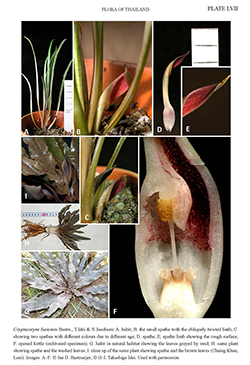e-Flora of Thailand
Volume 11 > Part 2 > Year 2012 > Page 231 > Araceae > Cryptocoryne
7. Cryptocoryne loeiensis Bastm., T.Idei & N.Jacobsen
Thai Forest Bull., Bot. 38: 181. 2010. Plate LVII.
Accepted Name : This is currently accepted.
Description : Creeping rhizome with strongly developed contractile roots. Leaves linear to lanceolate with a pronounced main vein, to 30 by 2 cm, gradually tapering to a fine point, base narrowly to shortly attenuate, margin somewhat undulate, irregularly denticulate, green and, under exposed light conditions, brownish tinged and with darker markings; petiole to 8 cm long, reddish in sunlight; spathe ca 5–6 cm long; kettle ca 1.5 by 0.6 cm, with a thickened wall just about the middle inside, lower inside wall white, upper part with alveoli; valve whitish, red streaked, walls red to reddish with small white blotches continuing upwards to the tube; tube ca 2–3 cm in length; limb shortly upright to obliquely forward twisted, the inner surface evenly rough throughout, evenly brown to red purple; collar absent; pistillate flowers 6; stigmas round, almost vertical; olfactory bodies irregularly rounded, purplish; staminate flowers about 50–60, yellow, surface of the thecae rough from protruding cells. Infructescence unknown. Chromosome number: 2n = 36.
Thailand : NORTH-EASTERN: Loei (Chiang Khan, along the Mekong – type: Bastmeijer 1145a, holotype -BKF, isotypes -C L).
Distribution : Undoubtedly also in Laos, along the Mekong.
Ecology : According to Takashige Idei who collected it first in March 2006, Cryptocoryne Loeiensis grows on river banks that are emerged during the dry season from February–April (flowering period), in partial sun. In such places with a strong water current in the flood season, it can be found sheltered between rocks and big stones or on leeward places in the winding riverbed, and, in sheltered places, it can also be found growing in sand and gravel and more or less mud-covered. It has been found growing together with different varieties of C. crispatula.
Notes: During high water the leaves become small and terete and, when emerging, the leaves and spathes develop (as in Cryptocoryne crispatula var. crispatula).
In its vegetative parts Cryptocoryne loeiensis resembles C. crispatula, but differs by the small spathe with the shortly upright to obliquely twisted limb which has a rugose surface, a character not found in C. crispatula.

